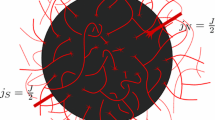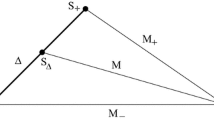Abstract
We calculate the number of degrees of freedom in spin network states related to the general area spectrum in loop quantum gravity based on the ABCK framework. We find that a black hole entropy (the logarithm of the degrees of freedom) is proportional to its area but it provides us with a different value of the Barbero–Immirzi parameter (γ=0.9284… or 0.7274…). It means that one should be careful in choosing the area spectrum when we describe a horizon area in full quantum gravity.
Similar content being viewed by others
Notes
Here we consider the condition A j ≦A but not the interval [A−δA,A+δA], which is more appropriate condition for fixing the area. However, this difference does not affect the final result. Because of the expression (21), we find \(S:=\ln W=\ln(\frac{dN}{dA}\delta A ) \approx\ln N(A)\) for A→∞.
References
J.D. Bekenstein, Phys. Rev. D 5, 1239 (1972)
S.W. Hawking, Commun. Math. Phys. 25, 167 (1972)
A. Strominger, C. Vafa, Phys. Lett. B 379, 99 (1996)
J.M. Maldacena, A. Strominger, Phys. Rev. Lett. 77, 428 (1996)
C. Rovelli, Phys. Rev. Lett. 77, 3288 (1996)
A. Ashtekar, J. Baez, A. Corichi, K. Krasnov, Phys. Rev. Lett. 80, 904 (1998)
A. Ashtekar, J. Baez, K. Krasnov, Adv. Theor. Math. Phys. 4, 1 (2000)
M. Bojowald, Living Rev. Relativ. 8, 11 (2005)
A. Ashtekar, T. Pawlowski, P. Singh, Phys. Rev. D 74, 084003 (2006)
J. Natario, R. Schiappa, Adv. Theor. Math. Phys. 8, 1001 (2004)
O. Dreyer, Phys. Rev. Lett. 90, 081301 (2003)
S. Hod, Phys. Rev. Lett. 81, 4293 (1998)
T. Tamaki, H. Nomura, Phys. Rev. D 70, 044041 (2004)
T. Thiemann, Modern Canonical Quantum General Relativity (Cambridge University Press, Cambridge, 2007). arXiv:gr-qc/0110034
C. Rovelli, L. Smolin, Phys. Rev. D 52, 5743 (1995)
C. Rovelli, L. Smolin, Nucl. Phys. B 442, 593 (1995). Erratum, ibid., 456, 753 (1995)
A. Ashtekar, J. Lewandowski, Class. Quantum Gravity 14, A55 (1997)
J.F.G. Barbero, Phys. Rev. D 51, 5507 (1995)
G. Immirzi, Nucl. Phys. B, Proc. Suppl. 57, 65 (1997)
A. Ashtekar, A. Corichi, K. Krasnov, Adv. Theor. Math. Phys. 3, 419 (1999)
J. Engle, A. Perez, K. Noui, Phys. Rev. Lett. 105, 031302 (2010)
J. Engle, K. Noui, A. Perez, D. Pranzetti, Phys. Rev. D 82, 044050 (2010)
J.F.G. Barbero, E.J.S. Villasenor, Class. Quantum Gravity 26, 035017 (2009)
K.A. Meissner, Class. Quantum Gravity 21, 5245 (2004)
M. Domagala, J. Lewandowski, Class. Quantum Gravity 21, 5233 (2004)
A. Alekseev, A.P. Polychronakos, M. Smedback, Phys. Lett. B 574, 296 (2003)
A.P. Polychronakos, Phys. Rev. D 69, 044010 (2004)
I.B. Khriplovich, arXiv:gr-qc/0409031
I.B. Khriplovich, arXiv:gr-qc/0411109
A. Ghosh, P. Mitra, Phys. Lett. B 616, 114 (2005)
A. Ghosh, P. Mitra, Int. J. Mod. Phys. 80, 867 (2006)
A. Ghosh, P. Mitra, Phys. Rev. D 74, 064026 (2006)
T. Tamaki, H. Nomura, Phys. Rev. D 72, 107501 (2005)
H. Sahlmann, Phys. Rev. D 76, 104050 (2007)
H. Sahlmann, Class. Quantum Gravity 25, 055004 (2008)
T. Tamaki, Class. Quantum Gravity 24, 3837 (2007)
I. Agulló, J.F. Barbero G, J. Díaz-Polo, E. Fernández-Borja, E.J.S. Villaseñor, Phys. Rev. Lett. 100, 211301 (2008)
I. Agulló, J. Díaz-Polo, E. Fernández-Borja, Phys. Rev. D 77, 104024 (2008)
J.F.G. Barbero, E.J.S. Villaseñor, Phys. Rev. D 77, 121502(R) (2008)
M.A. Nielsen, I.L. Chuang, Modern Quantum Computation and Quantum Information (Cambridge University Press, Cambridge, 2000)
L. Bombelli, R.K. Koul, J. Lee, R.D. Sorkin, Phys. Rev. D 34, 373 (1986)
’t Hooft, arXiv:hep-th/0003004
D.R. Terno, Int. J. Mod. Phys. D 14, 2307 (2005)
E.R. Livine, D.R. Terno, Nucl. Phys. B 741, 131 (2006)
W. Donnelly, Phys. Rev. D 77, 104006 (2008)
M.H. Ansari, Nucl. Phys. B 783, 179 (2007). Erratum, ibid., 795, 635 (2008)
K. Krasnov, C. Rovelli, Class. Quantum Gravity 26, 245009 (2009)
H. Sahlmann, Phys. Rev. D 84, 044049 (2011)
S. Kloster, J. Brannlund, A. DeBenedictis, Class. Quantum Gravity 25, 065008 (2008)
R. Bousso, J. High Energy Phys. 07, 004 (1999)
A. Ashtekar, E. Wilson-Ewing, Phys. Rev. D 78, 064047 (2008)
J.F. Barbero G, J. Lewandowski, E.J.S. Villaseñor, Phys. Rev. D 80, 044016 (2009)
Acknowledgements
We would like to thank Kei-ichi Maeda for critical reading and useful comments. We would also like to acknowledge Tomohiro Harada for valuable discussions and continuous encouragement.
Author information
Authors and Affiliations
Corresponding author
Appendix: The Laplace transformation
Appendix: The Laplace transformation
We introduce the Laplace transformation of N(a) by
where a=A/4πγ. Integrating (31) over a from 0 to ∞ we get one exact equation:
where

with \(\tilde{a}_{x}(n,s,t)=a_{x}(n,s,t)/4\pi\gamma\) and \(\tilde{a}_{y}(n,s,t) =a_{y}(n,\allowbreak s,t)/4\pi\gamma\). In order to obtain N(a), we must perform the inverse Laplace transformation of P(L). We use the well-known fact that N(a) is determined by the poles of P(L). We find
This is the form (21) which was used in Sect. 3. Now we search zeros L i which satisfy G(L i )−1=0.
We find that the only one real zero is given by
Near this zero, the function P(L) behaves as
where
The leading behavior for large a is given by

where \(\gamma_{M}=\tilde{\gamma}_{M}/\pi(=0.9284\ldots)\).
It is easy to prove that all complex zeros L i (i=1,2,…), i.e., the complex poles of P(L i ), with no vanishing imaginary part must have smaller real part than \(\tilde{\gamma}_{M}\) as follows: Since G(L i ) must be 1 on the poles, let us focus on the real part of G(L i ). Defining \(L_{i}:=L_{i}^{(1)}+i L_{i}^{(2)}\), we find that \(\mathrm{Re} [\mathrm{e}^{-L_{i}\tilde{a}_{x}} ]\)= \(\mathrm{e}^{-L_{i}^{(1)}\tilde{a}_{x}}\cos(L_{i}^{(2)} \tilde {a}_{x} )\). To satisfy G(L i )=1, \(L_{i}^{(1)}\) (i=1,2,…) must be smaller than \(\tilde{\gamma}_{M}\).
We show the values of the poles of P(L) for Re[L i ]>2 and |Im[L i ]|<100 in Table 1, which are solved numerically. In comparison with the leading relation (A.1), the complex zeros’ contribution to N(a) is exponentially smaller.
Rights and permissions
About this article
Cite this article
Tanaka, T., Tamaki, T. Area spectrum of horizon and black hole entropy. Eur. Phys. J. C 73, 2314 (2013). https://doi.org/10.1140/epjc/s10052-013-2314-0
Received:
Revised:
Published:
DOI: https://doi.org/10.1140/epjc/s10052-013-2314-0




